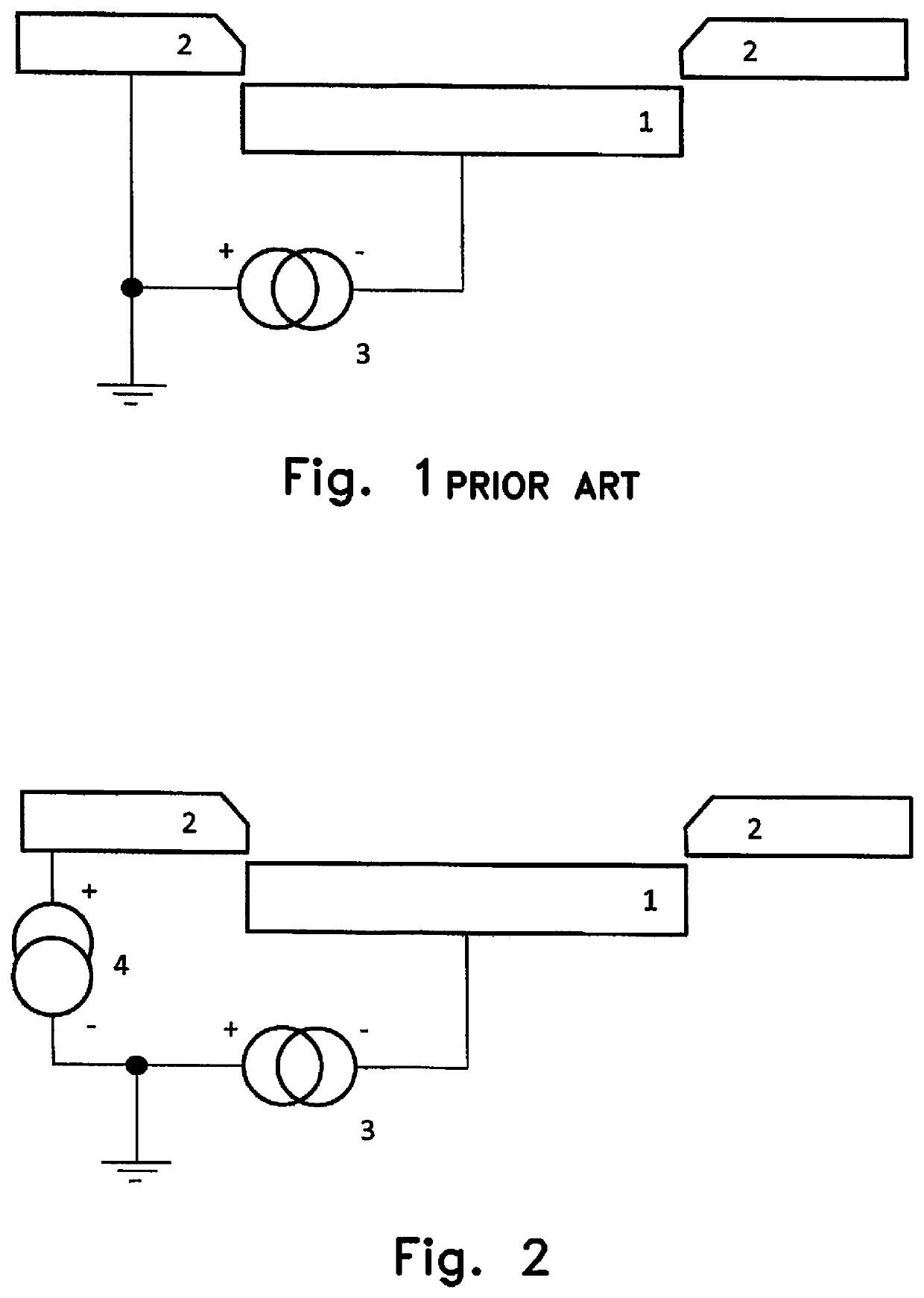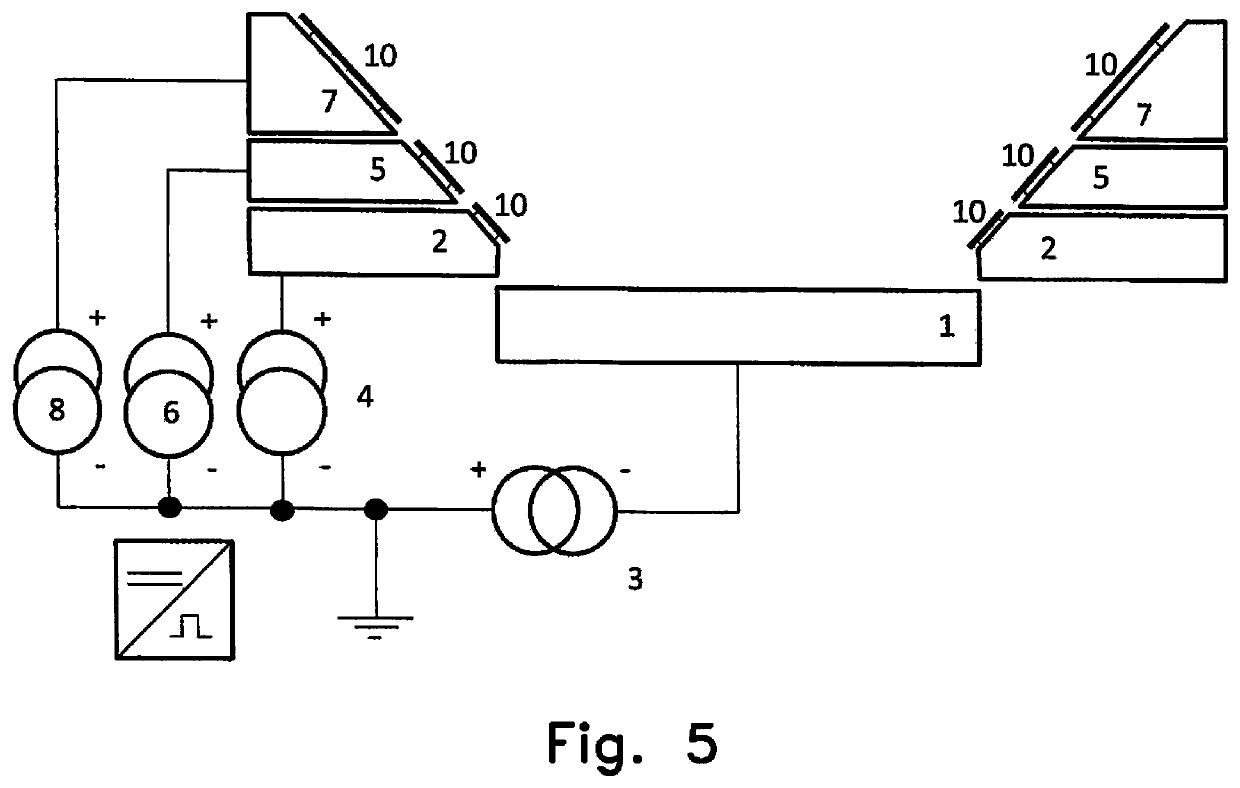Arrangement for coating substrate surfaces by means of electric arc discharge
a technology of electric arc discharge and substrate surface, which is applied in the direction of ion implantation coating, coating, electrical apparatus, etc., can solve the problems of negative consequences, disadvantageous layer properties, and relatively low energies of coating particles
- Summary
- Abstract
- Description
- Claims
- Application Information
AI Technical Summary
Benefits of technology
Problems solved by technology
Method used
Image
Examples
example 1
[0051]An arrangement in accordance with FIG. 2 is present, wherein the anode 2 can additionally be covered with a covering 10 composed of graphite in accordance with FIG. 5.
[0052]A process in which metallic substrates are coated with an AlTiOxNy layer is carried out. Firstly, the substrates are chemically cleaned, dried and arranged on mounts in the vacuum chamber. Evacuation to 10−3 Pa is followed by ion cleaning using argon ions. The subsequent coating takes place with the use of a target 1, which is connected as a cathode and is a plate composed of AlTi having the composition (66:33 at %). As reactive gases, a mixture of nitrogen and oxygen in a ratio of 70:30% by volume at a pressure of 1 Pa is fed into the vacuum chamber. With an electric discharge current of 100 A at the electric current source 3 and an electric voltage at the target 1, target material is progressively vaporized by means of an electric arc discharge. The electric voltage of the anode current source 4 is set to...
example 2
[0054]An arrangement in accordance with FIG. 5 is used. A process is carried out in which a forming tool having depressions (cavities) is intended to be coated as substrate. The coating is effected with an AlCrSiN layer. Firstly, the tool is chemically cleaned, dried and arranged in the vacuum chamber such that the coating plasma can reach the working surfaces of the tool. Evacuation to 10−3 Pa is followed by ion cleaning using argon ions. The subsequent coating is carried out with the use of the target 1, which is connected as a cathode and is a plate composed of AlCrSi having the composition (66:29:5 at %). As reactive gas, nitrogen at a pressure of 1 Pa is introduced into the vacuum chamber. With an electric discharge current of 100 A at the current source 3, target material is progressively vaporized by means of an electric arc discharge. The electric voltage of the current source 4 for the first anode 2 is set to 5 V, and the electric voltage at the current source 6, to which t...
example 3
[0057]An arrangement in accordance with FIG. 6 is present. A process is carried out in which complexly shaped tools are intended to be coated. The coating is effected with an AlCrN layer. Firstly, the tools as substrates are chemically cleaned, dried and arranged on rotatable substrate holders (planetary) in the vacuum chamber such that the tools are guided past the target 1, which is connected as a cathode, with constant rotation in three axes. Evacuation to 10−3 Pa is followed by ion cleaning using argon ions. The subsequent coating is carried out with the use of a plate composed of AlCr having the composition (70:30 at %) as the target 1. As reactive gas, nitrogen at a pressure of 1 Pa is introduced into the vacuum chamber. With an electric discharge current of 100 A at the current source 3, to which the target 1 is connected, target material is progressively vaporized by means of an electric arc discharge. The electric voltage of the current source 4, to which the first anode 2 ...
PUM
| Property | Measurement | Unit |
|---|---|---|
| positive electric voltage potential | aaaaa | aaaaa |
| positive electric voltage potential | aaaaa | aaaaa |
| distance | aaaaa | aaaaa |
Abstract
Description
Claims
Application Information
 Login to View More
Login to View More - R&D
- Intellectual Property
- Life Sciences
- Materials
- Tech Scout
- Unparalleled Data Quality
- Higher Quality Content
- 60% Fewer Hallucinations
Browse by: Latest US Patents, China's latest patents, Technical Efficacy Thesaurus, Application Domain, Technology Topic, Popular Technical Reports.
© 2025 PatSnap. All rights reserved.Legal|Privacy policy|Modern Slavery Act Transparency Statement|Sitemap|About US| Contact US: help@patsnap.com



